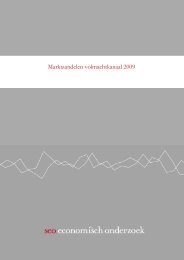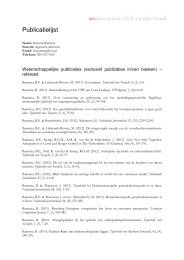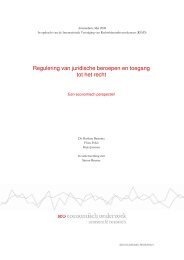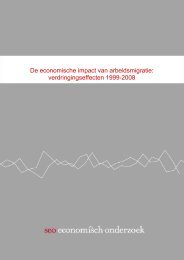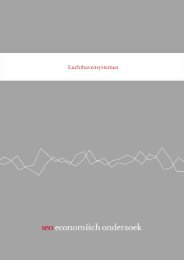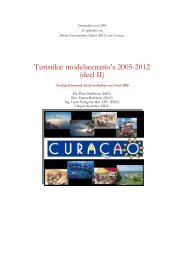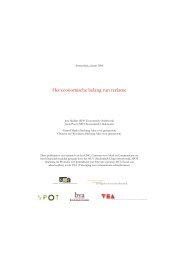Amsterdam, Netherlands - SEO Economisch Onderzoek
Amsterdam, Netherlands - SEO Economisch Onderzoek
Amsterdam, Netherlands - SEO Economisch Onderzoek
You also want an ePaper? Increase the reach of your titles
YUMPU automatically turns print PDFs into web optimized ePapers that Google loves.
The central government is responsible for macro-economic and social-distributional policies. Italso collects the bulk of taxes (taxes on income, profits and capital gains, taxes on property, taxeson goods and services, etc.) and subsequently allocates large amounts of tax revenues to lowerlevelgovernments via targeted funds (called Gemeentefonds for the city communities andProvinciefonds for the provinces).Provinces are responsible for the coordination of a number of public policies, such as planning,transport, culture and social affairs. They also have legal control over the municipalities (notablyin the domain of planning where they approve the municipal land use plan) and over waterboards, and they maintain some operating responsibilities for a few policy sectors like themanagement of the road system. In addition, the provinces correspond with the territorial level ofdeconcentration of some ministries such as those for administering public works, watermanagement and agriculture (OECD, 2007: 159).Municipalities are responsible for a wide range of policy sectors like roads, public transport,housing, local planning, environment, social affairs, economic development, education, healthcare, etc. The municipalities share many of their responsibilities with the central government, butthey are relatively independent. The central government establishes the general framework, rulesand norms that local authorities must follow, monitors most policies’ implementation andcontrols the funding for most policy sectors (OECD, 2007: 159-60). Despite their broadresponsibilities, Dutch municipalities have limited opportunities to impose local taxes. Arelatively small proportion of municipal revenues are raised by local taxes. In 2006, about 5% oftotal tax revenues were levied at the local level. After part of the municipal property tax wasabolished in 2006, however, the proportion of taxes levied at the local level has currently declinedbelow 1% (OECD, 2007).Like most municipalities in the <strong>Netherlands</strong>, <strong>Amsterdam</strong> is run by a city council, governed by amayor, aldermen, and the municipal council. However, unlike most other Dutch municipalities,<strong>Amsterdam</strong> is subdivided into fifteen boroughs (stadsdelen), a system that was implemented inthe 1980s to improve local governance. The boroughs are responsible for many activities that hadpreviously been run by the central city. Fourteen of these have their own council, chosen by apopular election. The fifteenth, Westpoort, covers the harbor of <strong>Amsterdam</strong> and therefore hasvery few residents. For this reason, Westpoort is governed by the central municipal council. Localdecisions are made at borough level, and only affairs pertaining to the whole city, such as majorinfrastructure projects, are handled by the central city council.With respect to regional economic policy, the central government’s policy is aimed at enablingeach region to provide the same level of public goods and services. This takes place via generaland specific grants that are allocated to both provincial and (principally) to municipalgovernments. They are calculated according to criteria that try to take factors into account tocompensate for regional cost differences and differences in revenue raising capacity. Centralstandards and limited local fiscal autonomy ensure that regional differences remain small.Policies promoting regional development are limited (OECD, 2007a: 121-2). With the publicationof the 2004 report Pieken in de Delta by the Ministry of Economic Affairs, regional economicpolicy in the <strong>Netherlands</strong> has shifted towards a focus on strengthening economic key regions,such as the North and South Wings of the Randstad. The goal is to exploit region-specificopportunities of national significance and to make use of the regional potential to create aninternationally competitive investment climate. In the North Wing of the Randstad, whichincorporates the <strong>Amsterdam</strong> metropolitan area, a number of sectors have been selected that aresupported: creative industry, innovative logistics, trade, tourism, and life sciences and the medicalcluster. Within these clusters projects were selected in 2006. Over the period 2007-2010 they willreceive EUR 271 million from the Ministry of Economic Affairs (OECD, 2007a: 123).28



